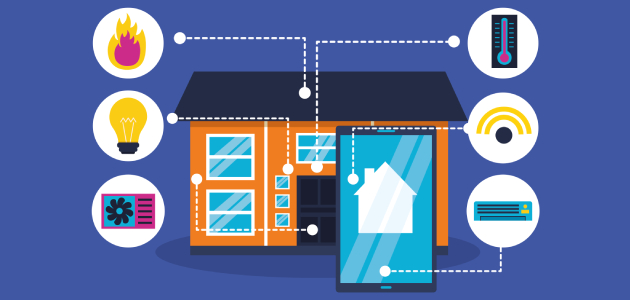You’ve probably encountered some form of home automation already, whether it’s a “hub” like Amazon’s Alexa or just a smart thermostat.
But what exactly is home automation? What does it do? And why should you care?
Let’s take a look.

Automation vs. Control
It may sound strange, but not all of the features touted as “home automation” are actually automated. Many of them operate through direct control.
For instance, if it’s too hot in your living room, you open an app on your phone, and remotely turn down the thermostat.
Of course, you can also automate it. In this case, you might use the app to schedule the thermostat to adjust at a certain time each day.
In short, “home automation” enables and encapsulates both automation and control.
What Can You Automate?
What people choose to automate depends on their personal preferences – and what technology is available at the time. But most home automation features can be grouped into one of these three categories:
• Efficiency: Conserve energy with lights that turn off automatically, a thermostat that adjusts itself based on the time of day, and get notifications for water leaks.
• Convenience: Set the blinds to close at a set time each day to block out an annoying glare, turn on the lights and heat when you’re almost home, or control your robot vacuum cleaner.
• Security: Lock or unlock doors remotely, get notifications when motion is detected, and monitor a surveillance camera remotely.
In short, whether you want to save money (or the environment), protect your home and family, or simply make your life a little easier, home automation can help.
What Do You Need to Automate Your Home?
There are so many different gadgets coming out within the smart technology industry, that it can be hard to know where to start. There are even robot lawn mowers and automated pool cleaners!
Fortunately, there’s no need to spend a fortune having your entire home automated from day one.
You can start with one gadget (or three), and slowly add more as you see fit. To give you some ideas on what to get first, here are some of the most commonly used home automation devices:
• Hubs
• Thermostats
• Lights
• Locks
• Appliances
• Plugs
A good hub will allow you to connect and control all of your devices from one place. Devices you already use, like Amazon Alexa and Apple’s Siri, can be used as hubs, but there are also dedicated hubs offered by companies like Ezlo and Logitech.
But don’t think that the hub has to be the first thing you buy. This upcoming smart plug from Vera, for instance, comes with a built-in home control hub, meaning it can be controlled or automated right from your smartphone. And it retails for only $39.95, making it a cheap and easy entry point into home automation.
Did I just make a “plug” for a plug? I guess I did.
Anyways, smart plugs can be used with all sorts of devices and appliances, whether it’s a TV, coffee maker, space heater, or electric blinds. But there’s no real “right” choice when picking your first smart home device. It really just depends on your needs.
What are yours?



